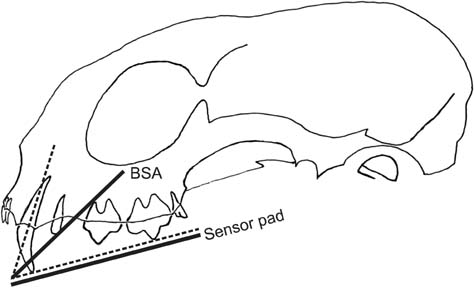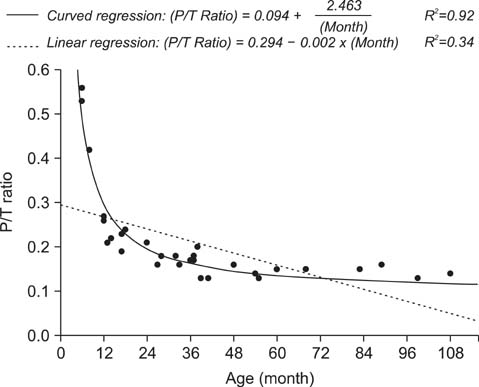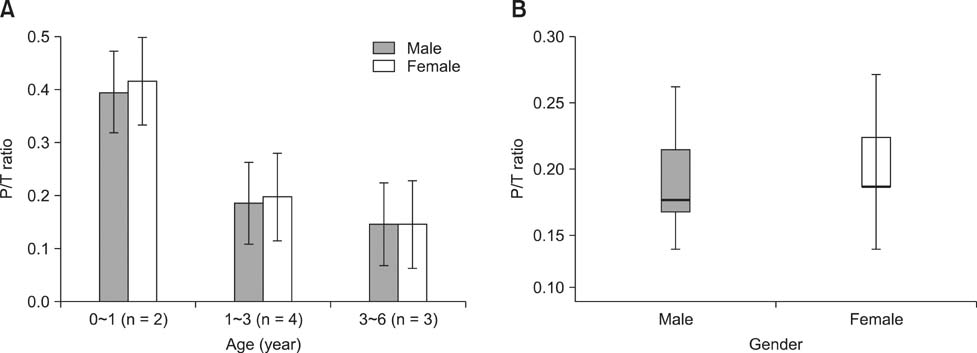J Vet Sci.
2014 Dec;15(4):557-561. 10.4142/jvs.2014.15.4.557.
Determining the age of cats by pulp cavity/tooth width ratio using dental radiography
- Affiliations
-
- 1Research Institute for Veterinary Science, College of Veterinary Medicine, Seoul National University, Seoul 151-742, Korea. kmseo@snu.ac.kr
- KMID: 2070243
- DOI: http://doi.org/10.4142/jvs.2014.15.4.557
Abstract
- The purpose of this study was to evaluate the effect of age on the ratio of pulp cavity/tooth width (P/T ratio) in healthy cats. The dental radiographs of 32 cats (16 males and 16 females) were generated with a digital dental X-ray unit with the animals under general anesthesia. Standardized measurement of the canine teeth was performed by drawing a line on the radiograph perpendicular to the cementoenamel junction (CEJ) of the tooth. There was an inversely proportional correlation between chronological age and the P/T ratio. Moreover, a strong Pearson squared correlation (gamma2 = 0.92) was identified by the curved regression model. No significant differences in the P/T ratio based on gender or breed were found. These results suggest that determination of age by P/T ratio could be clinically useful for estimating the chronological age of cats.
Keyword
MeSH Terms
Figure
Reference
-
1. Bass WM. Developments in the identification of human skeletal material (1968-1978). Am J Phys Anthropol. 1979; 51:555–562.
Article2. Cameriere R, De Luca S, Alemán I, Ferrante L, Cingolani M. Age estimation by pulp/tooth ratio in lower premolars by orthopantomography. Forensic Sci Int. 2012; 214:105–112.
Article3. Karkhanis S, Mack P, Franklin D. Age estimation standards for a Western Australian population using the coronal pulp cavity index. Forensic Sci Int. 2013; 231:412.e1–412.e6.
Article4. Kershaw K, Allen L, Lisle A, Withers K. Determining the age of adult wild dogs(Canis lupus dingo, C. 1. domesticus and their hybrids). Wildlife Res. 2005; 32:581–585.
Article5. Knowlton FF, Whittemore SL. Pulp cavity-tooth width ratios from known-age and wild-caught coyotes determined by radiography. Wildlife Soc Bull. 2001; 29:239–244.6. Kringsholm B, Jakobsen J, Sejrsen B, Gregersen M. Unidentified bodies/skulls found in Danish waters in the period 1992-1996. Forensic Sci Int. 2001; 123:150–158.
Article7. Kvaal SI, Kolltveit KM, Thomsen IO, Solheim T. Age estimation of adults from dental radiographs. Forensic Sci Int. 1995; 74:175–185.
Article8. Liang X, Tang Y, Luo E, Zhu G, Zhou H, Hu J, Tang X, Wang X. Maxillofacial injuries caused by the 2008 Wenchuan earthquake in China. J Oral Maxillofac Surg. 2009; 67:1442–1445.
Article9. Linhart SB, Knowlton FF. Determining age of coyotes by tooth cementum layers. J Wildl Manage. 1967; 31:362–365.
Article10. Lommer MJ, Verstraete FJM, Terpak CH. Dental radiographic technique in cats. Compend Contin Educ PractVet. 2000; 22:107–117.11. Philippas GG. Influence of occlusal wear and age on formation of dentin and size of pulp chamber. J Dent Res. 1961; 40:1186–1198.
Article12. Sakuma A, Saitoh H, Suzuki Y, Makino Y, Inokuchi G, Hayakawa M, Yajima D, Iwase H. Age estimation based on pulp cavity to tooth volume ratio using postmortem computed tomography images. J Forensic Sci. 2013; 58:1531–1535.
Article13. Saunders S, DeVito C, Herring A, Southern R, Hoppa R. Accuracy tests of tooth formation age estimations for human skeletal remains. Am J Phys Anthropol. 1993; 92:173–188.
Article14. Sergeant DE, Pimlott DH. Age determination in moose from sectioned incisor teeth. J Wildl Manage. 1959; 23:315–321.
Article15. Solheim T. Amount of secondary dentin as an indicator of age. Scand J Dent Res. 1992; 100:193–199.
Article16. Star H, Thevissen P, Jacobs R, Fieuws S, Solheim T, Willems G. Human dental age estimation by calculation of pulp-tooth volume ratios yielded on clinically acquired cone beam computed tomography images of monoradicular teeth. J Forensic Sci. 2011; 56:Suppl 1. S77–S82.
Article17. Thevissen PW, Poelman G, De Cooman M, Puers R, Willems G. Implantation of an RFID-tag into human molars to reduce hard forensic identification labor. Part 2: Physical properties. Forensic Sci Int. 2006; 159:Suppl. S40–S46.
Article18. Tumlison R, McDaniel VR. Gray fox age classification by canine tooth pulp cavity radiographs. J Wildl Manage. 1984; 48:228–230.
Article
- Full Text Links
- Actions
-
Cited
- CITED
-
- Close
- Share
- Similar articles
-
- Comparison of dental radiography and computed tomography: measurement of dentoalveolar structures in healthy, small-sized dogs and cats
- The Application of Paewinsky et al.'s Age Estimation Method to Periapical Radiographs
- Age Estimation Using Attrition and Pulp Cavity Size of the Mandibular First Molar in Korean Population
- Age Estimation Based on Pulp Chamber Size of Mandibular First Molars from Intraoral Periapical Radiographs in Korean
- A comparative study of cone-beam computed tomography and digital panoramic radiography for detecting pulp stones







